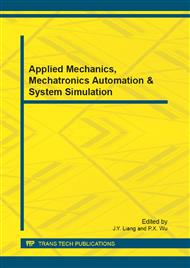[1]
A. Nosratinia and T. E. Hunter. Cooperative communiaction in wireless networks. IEEE Commun. Mag. no. 10, (2004), pp.74-80.
DOI: 10.1109/mcom.2004.1341264
Google Scholar
[2]
A. Sendonaris, E. Erkip and B. Aazhang. User cooperative diversity -part I: system description, and – part II: implementation aspects and performance analysis. IEEE Trans. Commun., vol. 51, no. 11, (2003), p.1927-(1948).
DOI: 10.1109/tcomm.2003.819238
Google Scholar
[3]
J. N. Laneman and G. W. Wornell, Distributed space- time-coded protocols for exploiting cooperative diversity in wireless networks, IEEE Trans. Inf. Theory, vol. 49, no. 10, (2003), pp.2414-2425.
DOI: 10.1109/tit.2003.817829
Google Scholar
[4]
J. N. Laneman, D. N. C. Tse, and G. W. Wornell. Cooperative diversity in wireless networks: efficient protocols and outage behavior. IEEE Trans. Inf. Theory, vol. 50, no. 12, (2004), pp.3062-3080.
DOI: 10.1109/tit.2004.838089
Google Scholar
[5]
C. Shuping, Z. Xing and W. Wenbo. Performance analysis of OSTBC transmission in amplify-and-forward cooperative relay networks. IEEE Trans. Veh. Technol., vol. 59, no. 1, (2010), pp.105-113.
DOI: 10.1109/tvt.2009.2024499
Google Scholar
[6]
Z. Guozheng, H. Bao hua. One scheme of cooperative diversity with two satellites based on the Alamouti code. IET 3rd International Conference on Wireless, Mobile and Multimedia Networks. (2010), pp.151-154.
DOI: 10.1049/cp.2010.0640
Google Scholar
[7]
Yi Zhao, Raviraj Adve and Teng Joon Lim. Improving amplify-and-forward relay networks: optimal power allocation versus selection. ISIT 2006, Seattle, USA, (2006), July 9-14.
DOI: 10.1109/isit.2006.262002
Google Scholar
[8]
R. U. Nabar, H. Bolcskei, and F. W. Kneubuhler. Fading relay channels: Performance limits and space-time signal design. IEEE Journal on Selected Areas in Communications, vol. 22. (2004), pp.1099-1109.
DOI: 10.1109/jsac.2004.830922
Google Scholar
[9]
Golnaz Farhadi and Norman C. Beaulieu. Low complexity receivers for coherent amplify-and-forward cooperative systems. IEEE transactions on communications, vol. 58, no. 10, (2010), pp.3001-3010.
DOI: 10.1109/tcomm.2010.091710.090037
Google Scholar
[10]
J. N. Laneman, D. N. C. Tse, and G. W. Wornell. Cooperative diversity in wireless networks: Efficient protocols and outage behavior. IEEE Transaction on Information Theory, vol. 50, (2004), pp.3062-3080.
DOI: 10.1109/tit.2004.838089
Google Scholar


